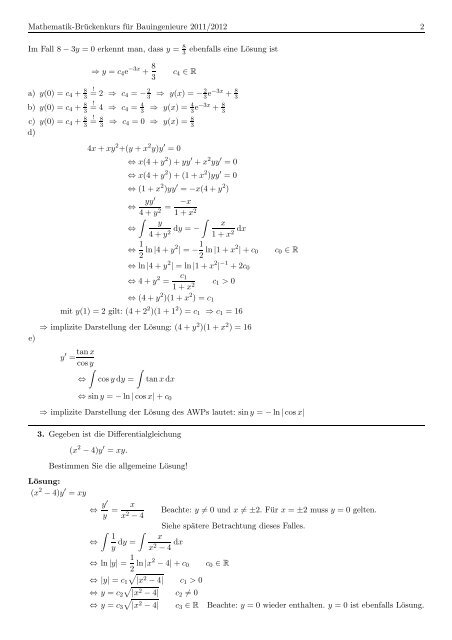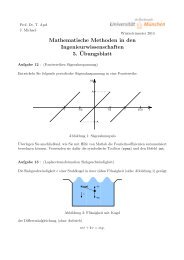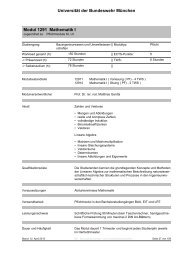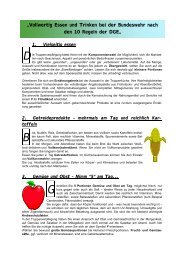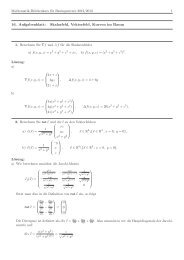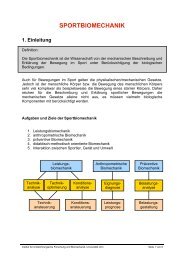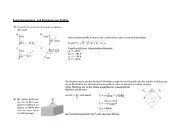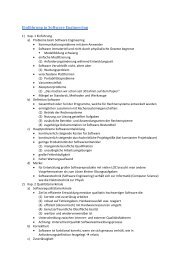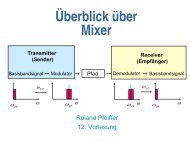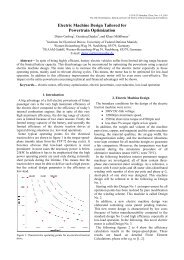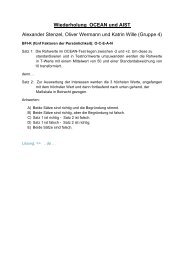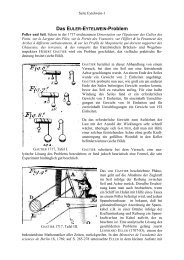12. Aufgabenblatt: gewöhnliche Differentialgleichungen und ...
12. Aufgabenblatt: gewöhnliche Differentialgleichungen und ...
12. Aufgabenblatt: gewöhnliche Differentialgleichungen und ...
Erfolgreiche ePaper selbst erstellen
Machen Sie aus Ihren PDF Publikationen ein blätterbares Flipbook mit unserer einzigartigen Google optimierten e-Paper Software.
Mathematik-Brückenkurs für Bauingenieure 2011/2012 2<br />
Im Fall 8−3y = 0 erkennt man, dass y = 8<br />
3<br />
a) y(0) = c4 + 8<br />
3<br />
b) y(0) = c4 + 8<br />
3<br />
c) y(0) = c4 + 8<br />
3<br />
d)<br />
e)<br />
⇒ y = c4e −3x + 8<br />
3<br />
!<br />
= 2 ⇒ c4 = − 2<br />
!<br />
= 4 ⇒ c4 = 4<br />
3<br />
3<br />
c4 ∈ R<br />
ebenfalls eine Lösung ist<br />
⇒ y(x) = −2<br />
3e−3x + 8<br />
3<br />
⇒ y(x) = 4<br />
3 e−3x + 8<br />
3<br />
!<br />
= 8<br />
3 ⇒ c4 = 0 ⇒ y(x) = 8<br />
3<br />
4x+xy 2 +(y +x 2 y)y ′ = 0<br />
⇔ x(4+y 2 )+yy ′ +x 2 yy ′ = 0<br />
⇔ x(4+y 2 )+(1+x 2 )yy ′ = 0<br />
⇔ (1+x 2 )yy ′ = −x(4+y 2 )<br />
⇔ yy′ −x<br />
=<br />
4+y 2 1+x 2<br />
<br />
y x<br />
⇔ dy = − dx<br />
4+y 2 1+x 2<br />
⇔ 1<br />
2 ln|4+y2 | = − 1<br />
2 ln|1+x2 |+c0 c0 ∈ R<br />
⇔ ln|4+y 2 | = ln|1+x 2 | −1 +2c0<br />
⇔ 4+y 2 = c1<br />
1+x 2 c1 > 0<br />
⇔ (4+y 2 )(1+x 2 ) = c1<br />
mit y(1) = 2 gilt: (4+2 2 )(1+1 2 ) = c1 ⇒ c1 = 16<br />
⇒ implizite Darstellung der Lösung: (4+y 2 )(1+x 2 ) = 16<br />
y ′ = tanx<br />
cosy<br />
<br />
⇔ cosydy =<br />
tanxdx<br />
⇔ siny = −ln|cosx|+c0<br />
⇒ implizite Darstellung der Lösung des AWPs lautet: siny = −ln|cosx|<br />
3. Gegeben ist die Differentialgleichung<br />
(x 2 −4)y ′ = xy.<br />
Bestimmen Sie die allgemeine Lösung!<br />
Lösung:<br />
(x 2 −4)y ′ = xy<br />
⇔ y′<br />
y<br />
= x<br />
x 2 −4<br />
Beachte: y = 0 <strong>und</strong> x = ±2. Für x = ±2 muss y = 0 gelten.<br />
Siehe spätere Betrachtung dieses Falles.<br />
<br />
1 x<br />
⇔ dy =<br />
y x2 −4 dx<br />
⇔ ln|y| = 1<br />
2 ln|x2 −4|+c0 c0 ∈ R<br />
<br />
⇔ |y| = c1 |x2 −4| c1 > 0<br />
<br />
⇔ y = c2 |x2 −4| c2 = 0<br />
<br />
|x2 −4| c3 ∈ R Beachte: y = 0 wieder enthalten. y = 0 ist ebenfalls Lösung.<br />
⇔ y = c3


